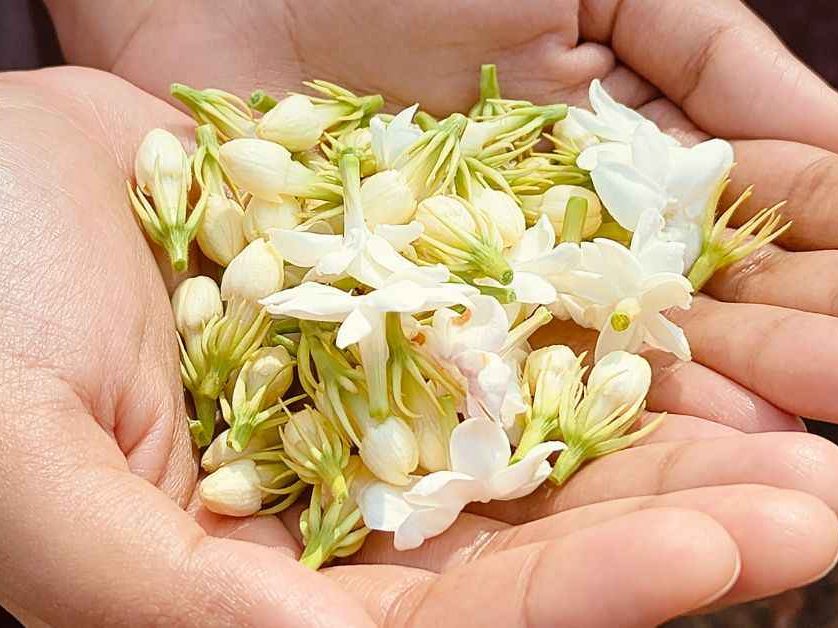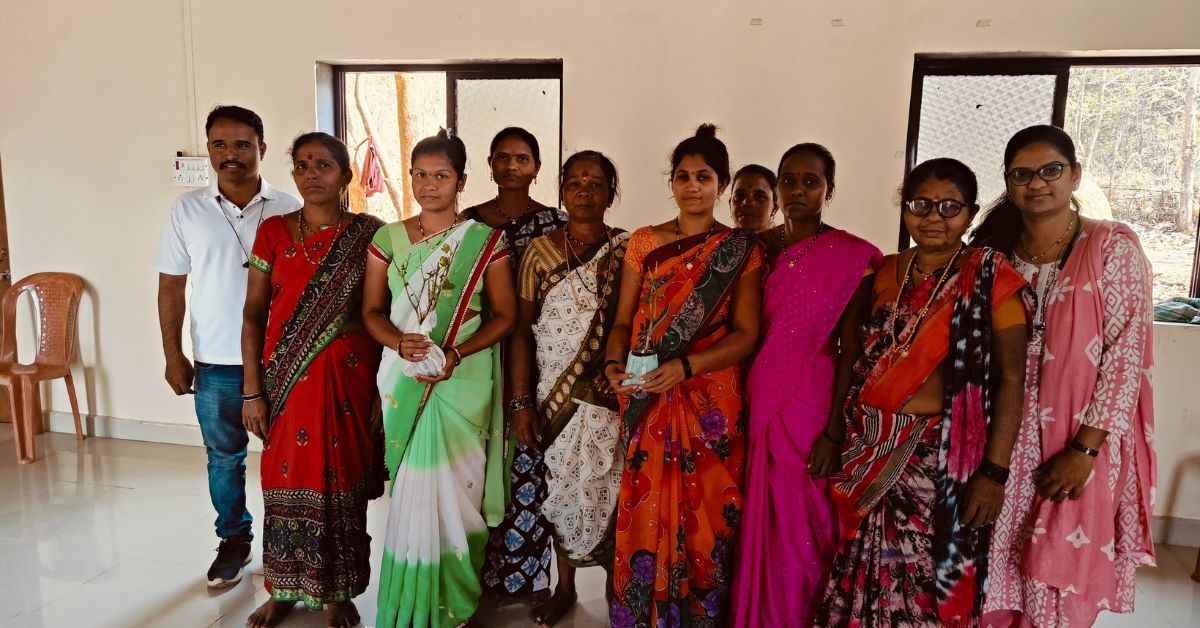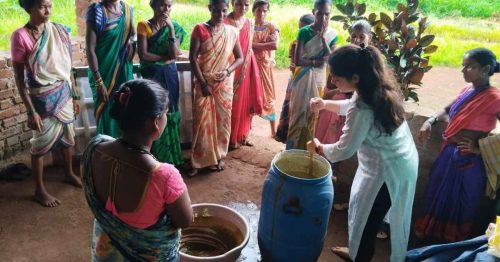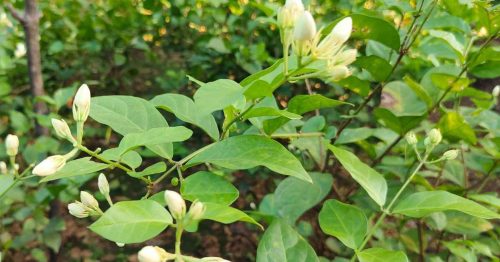Tara Kurkute admires the freshly picked jasmine buds in her hands, exclaiming, “Kitti sundar dista” (How beautiful they look). Her fifty-five-year-old neighbour, Venubai Pandurang Gavit, proudly displays her collection of mogra flowers.
The Kurkute family begins their day at 4 a.m. Mahendra (30), along with his parents, Tara (55) and Krishna (60), heads out with battery-powered torches to their jasmine fields at the foothills of Mahuli in the Sahyadri range. They carefully pluck the greenish-white buds and place them in cloth bags over their shoulders.

Later in the day, traders arrive to weigh and collect the flowers, which are then transported to markets in Kalyan and Dadar. Every fortnight, payments are made in cash, providing a steady income for families like the Kurkutes.
For the tribal communities of Shahpur in Maharashtra, jasmine cultivation has transformed their lives, making them more prosperous and beautiful, just like the flowers.
Jasmine has brought hope and stability
Not long ago, the life of these tribal communities was far from beautiful. For generations, the Katkari and Kokani tribes have struggled with poverty, landlessness, and seasonal migration in search of menial work. But today, the delicate fragrance of jasmine has brought hope, stability, and prosperity to their lives.
The Kurkutes, like the other tribal families in Shahpur, once relied solely on rain-fed agriculture, growing a single paddy crop during the Kharif season. With no irrigation access, despite living near the Tansa dam, whose water flows to Mumbai, they faced constant uncertainty. Land ownership was a distant dream, and without irrigation, farming was a gamble.
Once the paddy growing season is over, men are forced to migrate to nearby towns, namely Atgaon, Shahpur, Murbad, Vada, Kalyan Ulhasnagar, and Badlapur, in search of jobs like brick making, work as masons at construction sites, etc.
Women stayed behind, tending to children, scraping together meals from dwindling supplies, and taking on backbreaking odd jobs. The tribal community faces challenges like poverty, illiteracy, and limited access to essential services. Efforts by the government to improve their socio-economic conditions through various development initiatives have not helped much.
The Kurkutes of Ghartandpada in Koshte village, the Zugares of Gahtan in Khor village, the Thakares of Thakarepada in Wandre village, and the Barafs of Barapada in Aghai Village are forest dwellers. They are among the hundreds of tribal families of Shahpur who have benefitted from the amendments to the Forest Rights Act and become legal owners of plots they have been tilling for generations.
The Forest Rights Act (FRA), 2006, empowers forest-dwelling communities in India by recognising their rights to land and resources they have traditionally used. It grants individual and community rights to tribal and other forest-dependent people, ensuring their role in conservation while protecting them from eviction and displacement.

The FRA protects the tribal population from eviction without rehabilitation and settlement, in conjunction with the Right to Fair Compensation and Transparency in Land Acquisition, Rehabilitation and Settlement Act, 2013
Land ownership was another battle. For years, forest officials denied their rights to the land they had cultivated for generations. In 2017, 416 hectares of forest land in Koshte village were officially recognised for habitation and self-cultivation under the Forest Rights Act (FRA). “This was a long fight,” says Mahendra, an ITI-trained fitter who lost his job during COVID-19. “We lived in fear of eviction. Now we can farm peacefully.”
From uncertainty to opportunity: a new path for Tribal farmers
For generations, tribal communities near the Tansa dam have relied on rain-fed agriculture, cultivating just one paddy crop during the Kharif season. Ironically, though they live near a major water source for Mumbai, they lack access to it themselves. With erratic rainfall and no irrigation, farming has always been a gamble—one that often forces families to migrate in search of unskilled labor after the harvest.
That’s where the JSW Foundation and WOTR (Watershed Organization Trust) saw an opportunity to create lasting change. Their solution? A surprising yet promising alternative: jasmine cultivation.
Why Jasmine? A smart and sustainable choice
“We realised the plight of the tribals who had no choice but to leave their homes for work,” shares a JSW Foundation spokesperson. “So, we looked for a way to create local, sustainable livelihoods—and floriculture was the answer.”

The initiative zeroed in on 160 villages around Shahpur, just 28 km from JSW’s Vashind-based steel facility. Mogra (jasmine) was the perfect fit. “It’s drought-resistant, easy to cultivate, and has a high market demand,” explains Dnyaneswar Ade, WOTR’s project manager. With Mumbai’s bustling flower markets just a short distance away, farmers could directly tap into a lucrative customer base, reducing dependency on seasonal agriculture.
Support for jasmine farmers
Since its launch, the initiative has supported 234 tribal families across 18 villages by providing nearly one lakh jasmine saplings. Each family received 300–500 plants, depending on plot size, along with subsidies for fencing, pit digging, and drip irrigation systems worth ₹27,400 per farmer, funded by Maharashtra’s Agriculture Department.

Jasmine, known locally as Chameli, Malligai, Mogra, and Champa Bela, thrives in tropical and subtropical climates, making it well-suited for this region’s dry conditions. Jasminum sambac, the botanical name for jasmine, is easy to propagate through cuttings. The fragrant white flowers have nearly seven varieties, including Udupi Malligai, which holds Geographical Indication (GI) status and is highly sought after in West Asian markets.
For farmers like 40-year-old Subhash Ramchandra Zugare from Gathan Adivasi Pada in Khor village, jasmine offers multiple advantages: “Mogra survives droughts, requires minimal fertilizers, and has a stable market demand.”
Jasmine flowers sell for Rs 150 per kg on regular days and can fetch up to ₹300 per kg during festivals. Traders collect the flowers directly from villages, reducing transportation costs for farmers.
The shift to mogra cultivation has significantly improved incomes, with families earning an additional Rs 7,000 annually. Depending on the flowering season, monthly earnings range between Rs 2,000 to Rs 3,000, offering a sustainable livelihood to these communities.
Beyond Jasmine: Community development
Encouraged by Jasmine’s success, WOTR is now supporting village-level enterprises through Self-Help Groups (SHGs). These initiatives include producing incense sticks, papads, and paper plates, and flour milling services. In Koshte village alone, a flour mill run by Shivkanya Mahila SHG has saved residents from traveling 15 km to grind wheat.
Backyards in these hamlets now feature kitchen gardens and poultry farms—visible signs of improved livelihoods.
A new chapter for Adivasis
The shift to jasmine cultivation has reduced migration to cities for odd jobs. As Vandan Kakdya Tumbda (40) from Barafpada says, “Those who embraced mogra farming no longer need to leave their homes for work.”From hardship to hope, the journey of Shahpur’s tribals reflects resilience and renewal. The jasmine buds they once admired in their hands have blossomed into a brighter future—one where life is not just sustainable but truly sundar.
Edited by Leila Badyari; All images courtesy Hiren Bose


No comments:
Post a Comment